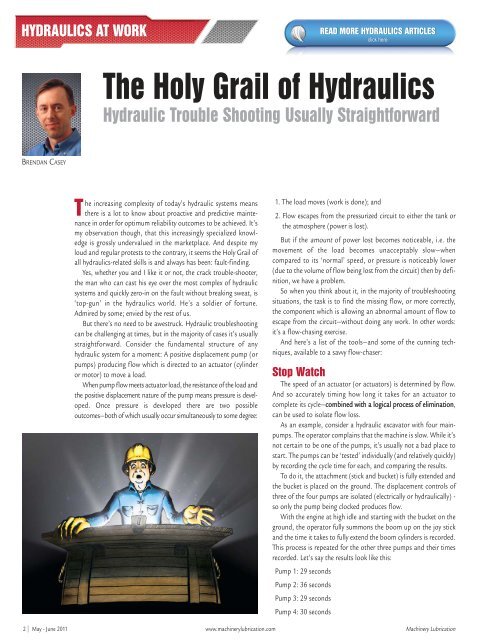Machinery Lubrication May June 2011 - Welcome to ECN Digital ...
Machinery Lubrication May June 2011 - Welcome to ECN Digital ...
Machinery Lubrication May June 2011 - Welcome to ECN Digital ...
Create successful ePaper yourself
Turn your PDF publications into a flip-book with our unique Google optimized e-Paper software.
HYDRAULICS AT WORK<br />
BRENDAN CASEY<br />
The increasing complexity of <strong>to</strong>day’s hydraulic systems means<br />
there is a lot <strong>to</strong> know about proactive and predictive maintenance<br />
in order for optimum reliability outcomes <strong>to</strong> be achieved. It’s<br />
my observation though, that this increasingly specialized knowledge<br />
is grossly undervalued in the marketplace. And despite my<br />
loud and regular protests <strong>to</strong> the contrary, it seems the Holy Grail of<br />
all hydraulics-related skills is and always has been: fault-finding.<br />
Yes, whether you and I like it or not, the crack trouble-shooter,<br />
the man who can cast his eye over the most complex of hydraulic<br />
systems and quickly zero-in on the fault without breaking sweat, is<br />
‘<strong>to</strong>p-gun’ in the hydraulics world. He’s a soldier of fortune.<br />
Admired by some; envied by the rest of us.<br />
But there’s no need <strong>to</strong> be awestruck. Hydraulic troubleshooting<br />
can be challenging at times, but in the majority of cases it’s usually<br />
straightforward. Consider the fundamental structure of any<br />
hydraulic system for a moment: A positive displacement pump (or<br />
pumps) producing flow which is directed <strong>to</strong> an actua<strong>to</strong>r (cylinder<br />
or mo<strong>to</strong>r) <strong>to</strong> move a load.<br />
When pump flow meets actua<strong>to</strong>r load, the resistance of the load and<br />
the positive displacement nature of the pump means pressure is developed.<br />
Once pressure is developed there are two possible<br />
outcomes—both of which usually occur simultaneously <strong>to</strong> some degree:<br />
1. The load moves (work is done); and<br />
2. Flow escapes from the pressurized circuit <strong>to</strong> either the tank or<br />
the atmosphere (power is lost).<br />
But if the amount of power lost becomes noticeable, i.e. the<br />
movement of the load becomes unacceptably slow—when<br />
compared <strong>to</strong> its ‘normal’ speed, or pressure is noticeably lower<br />
(due <strong>to</strong> the volume of flow being lost from the circuit) then by definition,<br />
we have a problem.<br />
So when you think about it, in the majority of troubleshooting<br />
situations, the task is <strong>to</strong> find the missing flow, or more correctly,<br />
the component which is allowing an abnormal amount of flow <strong>to</strong><br />
escape from the circuit—without doing any work. In other words:<br />
it’s a flow-chasing exercise.<br />
And here’s a list of the <strong>to</strong>ols—and some of the cunning techniques,<br />
available <strong>to</strong> a savvy flow-chaser:<br />
S<strong>to</strong>p Watch<br />
The speed of an actua<strong>to</strong>r (or actua<strong>to</strong>rs) is determined by flow.<br />
And so accurately timing how long it takes for an actua<strong>to</strong>r <strong>to</strong><br />
complete its cycle—combined with a logical process of elimination,<br />
can be used <strong>to</strong> isolate flow loss.<br />
As an example, consider a hydraulic excava<strong>to</strong>r with four mainpumps.<br />
The opera<strong>to</strong>r complains that the machine is slow. While it’s<br />
not certain <strong>to</strong> be one of the pumps, it’s usually not a bad place <strong>to</strong><br />
start. The pumps can be ‘tested’ individually (and relatively quickly)<br />
by recording the cycle time for each, and comparing the results.<br />
To do it, the attachment (stick and bucket) is fully extended and<br />
the bucket is placed on the ground. The displacement controls of<br />
three of the four pumps are isolated (electrically or hydraulically) -<br />
so only the pump being clocked produces flow.<br />
With the engine at high idle and starting with the bucket on the<br />
ground, the opera<strong>to</strong>r fully summons the boom up on the joy stick<br />
and the time it takes <strong>to</strong> fully extend the boom cylinders is recorded.<br />
This process is repeated for the other three pumps and their times<br />
recorded. Let’s say the results look like this:<br />
Pump 1: 29 seconds<br />
Pump 2: 36 seconds<br />
Pump 3: 29 seconds<br />
Pump 4: 30 seconds<br />
READ MORE HYDRAULICS ARTICLES<br />
click here<br />
The Holy Grail of Hydraulics<br />
Hydraulic Trouble Shooting Usually Straightforward<br />
2 <strong>May</strong> - <strong>June</strong> <strong>2011</strong> www.machinerylubrication.com <strong>Machinery</strong> <strong>Lubrication</strong>


